



Virgil Finlay was born July 23, 1914 in Rochester, New York. He was a star athlete in high school who went home after school and wrote poetry and drew pictures. Very little of his poetry ever saw print, but upwards of 2800 drawings and paintings, most printed on cheap pulp paper, made him the most famous fantasy illustrator of mid-twentieth century. (We'll give Frank Frazetta that honor for the last third.) How he ever managed to produce that quantity of quality images is a mind-boggling mystery once his techniques are explored.
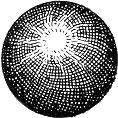
 He studied
art vigorously in high school and it was there that he discovered
scratchboard, his medium of choice. Scratchboard today is artboard
with a white clay coating covered in black ink that can be scratched
away with a scribe or knife or other sharp instrument to reveal
a white line. It is often used to simulate a wood engraving. When
Finlay started using it in the early thirties, the black was applied
by the artist. That is, scratchboard was white. Black ink was
applied to the surface and after it was dry, it was scraped off
by the artist. This is called "working from black to white"
(see butterfly at left) and is just the opposite of putting a
black ink line on a white sheet of paper ("working from white
to black" - see globe above right). Finlay chose to use both
techniques on the same drawing: filling areas with black so that
he could scratch through to the white to achieve a specific tone
of gray and also creating his middle tones and grays with hatching
and stippling in black ink on the white surface.
He studied
art vigorously in high school and it was there that he discovered
scratchboard, his medium of choice. Scratchboard today is artboard
with a white clay coating covered in black ink that can be scratched
away with a scribe or knife or other sharp instrument to reveal
a white line. It is often used to simulate a wood engraving. When
Finlay started using it in the early thirties, the black was applied
by the artist. That is, scratchboard was white. Black ink was
applied to the surface and after it was dry, it was scraped off
by the artist. This is called "working from black to white"
(see butterfly at left) and is just the opposite of putting a
black ink line on a white sheet of paper ("working from white
to black" - see globe above right). Finlay chose to use both
techniques on the same drawing: filling areas with black so that
he could scratch through to the white to achieve a specific tone
of gray and also creating his middle tones and grays with hatching
and stippling in black ink on the white surface.
And how he could stipple. Finlay had discovered science fiction with Amazing Stories in 1927 and horror and fantasy with Weird Tales in 1928. He preferred the latter and by 1935 he was confident enough that he could provide better illustrations that he sent six unsolicited drawings to Farnsworth Wright, the editor of Weird Tales pulp. Finlay's stippling ability almost lost him the job as Wright was uncertain that such fine dots would reproduce on the cheap pulp paper. Fortunately a test print proved acceptable. Enough of the detail remained to provide the readers with the rare experience of seeing a new artistic genius explode fully developed onto the scene. He had four illustrations in that issue. It was December of 1935. Finlay was 21.
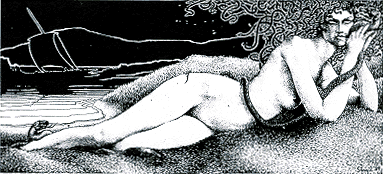
December 1935 Weird Tales
 Finlay's
work was an immediate hit with the readers and the
writers. Readers wrote in praising the illustrations. H.P. Lovecraft
wrote him fan letters and even composed a poem about his art.
Finlay was a fan of the genre as well as one of the most talented
artists to enter the field. These combined to provide his work
with a power and grace unknown in the pulps. The stippling, fine
hatching and pebble board were all used in conjunction to give
his images a texture and depth beyond anything ever seen in the
field. It's hard to show the degree of detail of his drawings
here on the web, but if you click on the small image at left you
can get a fair idea of the effort he put into his art.
Finlay's
work was an immediate hit with the readers and the
writers. Readers wrote in praising the illustrations. H.P. Lovecraft
wrote him fan letters and even composed a poem about his art.
Finlay was a fan of the genre as well as one of the most talented
artists to enter the field. These combined to provide his work
with a power and grace unknown in the pulps. The stippling, fine
hatching and pebble board were all used in conjunction to give
his images a texture and depth beyond anything ever seen in the
field. It's hard to show the degree of detail of his drawings
here on the web, but if you click on the small image at left you
can get a fair idea of the effort he put into his art.
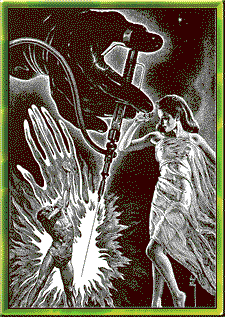 Once
you've seen the detail, it's important to understand how
he did it. A lot of artists use pebble board to simulate stippling.
The textured surface of the board prevents the pencil from filling
in the depths, making a seemingly random pattern of black dots.
Finlay did occasionally use pebble board, but his preferred method
of working was on the clay finish of scratchboard. Using an ultra-fine
lithographic pen, he would dip just the tip into India ink and
allow only the liquid ink, not the tip of the pen, to touch the
surface. He then wiped the residual ink off the pen point and
repeated the procedure for the next dot. This incredible and incredibly
labor-intensive technique, coupled with his enormous talent, created
images of near photographic quality - in the service of depicting
the fantastic. No one else ever made the unknowable seem so immediate
and real. (Click on the plate at right for a closeup view of the
stippling on the girl's face.)
Once
you've seen the detail, it's important to understand how
he did it. A lot of artists use pebble board to simulate stippling.
The textured surface of the board prevents the pencil from filling
in the depths, making a seemingly random pattern of black dots.
Finlay did occasionally use pebble board, but his preferred method
of working was on the clay finish of scratchboard. Using an ultra-fine
lithographic pen, he would dip just the tip into India ink and
allow only the liquid ink, not the tip of the pen, to touch the
surface. He then wiped the residual ink off the pen point and
repeated the procedure for the next dot. This incredible and incredibly
labor-intensive technique, coupled with his enormous talent, created
images of near photographic quality - in the service of depicting
the fantastic. No one else ever made the unknowable seem so immediate
and real. (Click on the plate at right for a closeup view of the
stippling on the girl's face.)
His reputation quickly spread. In addition to multiple illustrations is nearly every issue of Weird Tales through 1939, Wright chose him to illustrate the first in a proposed series of illustrated reprints of Shakespeare's plays. A Midsummer Night's Dream came out in 1936. I've never seen a copy. In 1938 he moved to New York City to take a staff position on The American Weekly, a Sunday supplement distributed with Hearst newspapers nationwide. A. Merritt was the editor. A wonderful collection of this work, titled Virgil Finlay in the American Weekly, was published in 1977. Look for it. It reprints his most fantastical and romantic work from 1938-1948. The actual magazines contain much more, including rare samples of his editorial and mainstream illustrations, as well as humorous fillers and headers for various columns, like the baking one below from 1940.

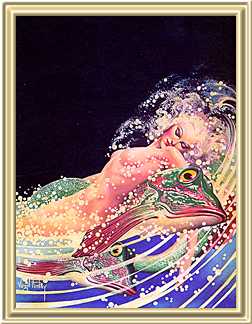 He
served in the Army from 1943 to 1946. Except for this hiatus,
he crafted hundreds of images for various science fiction pulps
throughout the forties. Included were: Famous Fantastic Mysteries
(his cover painting for the August 1942 issue at right demonstrates
his command of color), Fantastic Novels (where he illustrated
a half dozen stories by A. Merritt), Startling Stories,
Super Science Stories, Amazing Stories, Thrilling
Wonder Stories, Fantastic Adventures, Argosy,
and even a few comic books for DC. He continued to work for those
titles that lasted into the fifties. During that time, however,
the pulps were phased out of existence and the "digest"
was born. Rates decreased and making a living became more difficult.
He
served in the Army from 1943 to 1946. Except for this hiatus,
he crafted hundreds of images for various science fiction pulps
throughout the forties. Included were: Famous Fantastic Mysteries
(his cover painting for the August 1942 issue at right demonstrates
his command of color), Fantastic Novels (where he illustrated
a half dozen stories by A. Merritt), Startling Stories,
Super Science Stories, Amazing Stories, Thrilling
Wonder Stories, Fantastic Adventures, Argosy,
and even a few comic books for DC. He continued to work for those
titles that lasted into the fifties. During that time, however,
the pulps were phased out of existence and the "digest"
was born. Rates decreased and making a living became more difficult.
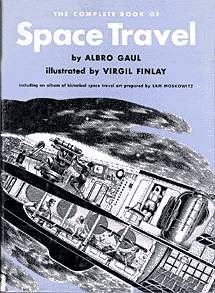
![]() He received a smattering of book assignments over the years: Seabury Quinn's Roads was published with
his illustrations in 1948 and A. Merritt's The Ship of Ishtar
in 1951. His most ambitious effort was the 1956 The Complete
Book of Space Travel. He shared cover billing with the author,
Albro Gaul, but it didn't allow him to "cross over"
into the non-sf markets. Some sf paperbacks of the sixties featured
his cover art. He even did a small b&w poster of Leonard Nemoy
as Mr. Spock.
He received a smattering of book assignments over the years: Seabury Quinn's Roads was published with
his illustrations in 1948 and A. Merritt's The Ship of Ishtar
in 1951. His most ambitious effort was the 1956 The Complete
Book of Space Travel. He shared cover billing with the author,
Albro Gaul, but it didn't allow him to "cross over"
into the non-sf markets. Some sf paperbacks of the sixties featured
his cover art. He even did a small b&w poster of Leonard Nemoy
as Mr. Spock.
Finlay consistently won fan polls and awards since their inception in 1940. When he went into the service, other illustrators were hired to draw in his style. The most successful of these mimics was Lawrence Sterne Stevens. Finlay won the first of the awards now known as the Hugo for best interior illustrator in 1953. His publishers issued portfolios of his drawings so the readers could see the images on better paper. Famous Fantastic Mysteries published three different ones in the forties. Nova Press issued one in 1953 (the hypo image above is taken from that portfolio), and Finlay friend and fanatic Gerry de la Ree released one shortly after his death in 1971.
Finlay's popularity was always high. Throughout the forties and fifties he was the most popular and saleable artist in science fiction. What was at issue was always his speed. The painstakingly slow techniques that resulted in the inimitable Finlay magic could not be rushed. Short cuts resulted in less satisfaction for both Finlay and the readers. He often did nothing but draw, sixteen hours a day, seven days a week to eke out a living at the wages that the pulps and digests could afford to pay. When markets would dry up as magazines floundered he was known to take jobs repairing lamps.

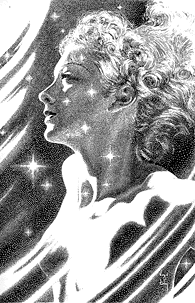 One
saving market that found Finlay in 1956 was the Astrology magazines.
They paid him better than the digests and continued to buy his
work right up to his last years. At left is a sample from 1969
and at right is an interior drawing from the same issue. Although
it's difficult to discern from the image, the entire drawing is
scratchboard, worked black to white.
One
saving market that found Finlay in 1956 was the Astrology magazines.
They paid him better than the digests and continued to buy his
work right up to his last years. At left is a sample from 1969
and at right is an interior drawing from the same issue. Although
it's difficult to discern from the image, the entire drawing is
scratchboard, worked black to white.
Finlay died in January of 1971, just prior to publication of Donald M. Grant's Virgil Finlay, the first book devoted to the man and his work. It contains illustrations reproduced from the original drawings, an Appreciation by Sam Moskowtiz, and a checklist by Gerry de la Ree. de la Ree would go on to publish six hardback collections of Finlay drawings starting with The Book of Virgil Finlay and ending with The Sixth Book of Virgil Finlay. All are recommended. It was there that the enormity of Finlay's talent was exposed for the first time. All the images were reproduced from the original art and printed on slick paper. The first volume was reprinted in softback by Avon/Flare and a seventh volume, Virgil Finlay Remembered, was issued in a very limited (200) hardback and also in softback.
Others collections of his work include An Astrological Sketch Book, which should not be ignored, Finlay's Illustrations for Weird Tales and Finlay's Femmes (two 1976 small portfolios), and Finlay's Lost Drawings for A Midsummer Night's Dream. The Underwood titles are compilations from the de la Ree books with additional material.
 To learn more about Virgil Finlay, see:
To learn more about Virgil Finlay, see:
| Virgil Finlay | Sam Moskowitz, Donald M. Grant, 1971 |
| Virgil Finlay Remembered | Gerry de la Ree, de la Ree 1981 |
| The Vadeboncoeur Collection of Knowledge | Jim Vadeboncoeur, Jr. 1998. |
|
Illustrations are copyright by their
respective owners. This page written, designed & © 1998 by Jim Vadeboncoeur, Jr. Updated 2011. |
